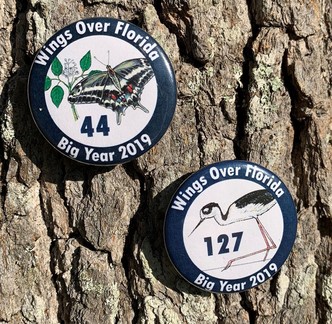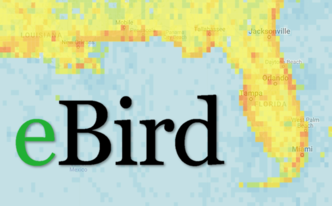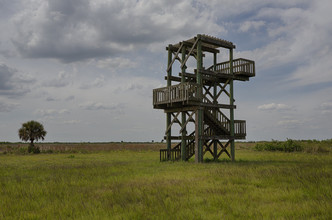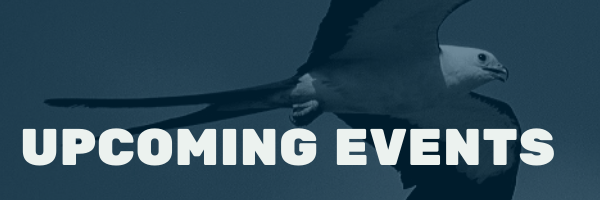|
As 2019 comes to a close we want to thank each and every one of you for joining us on the Great Florida Birding and Wildlife Trail. We have the wonderful job of helping you learn more about Florida’s unique wildlife and helping you find new and exciting places to visit. Every day we get to delve into some of the best birding opportunities in Florida so we can pass that information on to you.
The best part of working on the trail, by far, is getting to talk with wildlife watchers every day. Our constituents are a diverse bunch. You are birders, hikers and paddlers; you are Florida residents and visitors from across the country and around the world; you are park rangers, biologists and educators – but you all share a passion for our wildlife and the future of Florida’s natural spaces.
It truly is a privilege to work with you.
Liz Schold, Travis Blunden, and Anne Glick
FWC Wildlife Viewing Staff
 We are hard at work making our very first Big Year buttons!
Don’t forget to submit your application for your Wings Over Florida Big Year certificates! If you’ve seen at least 20 butterflies or 50 birds in 2019, you are eligible to receive a gorgeous frame-worthy certificate with your name and the number of species you saw. New this year, we will be making big year buttons, custom printed with your big year total so you can show off your accomplishment!

The short answer: it is enormous. eBird is one of the most ambitious citizen science projects of all time, compiling user observations into a database of nearly 40 million birding checklists from around the world. The database, app and website are all powerful tools with myriad uses.
Using the app on your phone, it is easy to record where and when you’ve seen different species – an invaluable tool if you’re a lister trying to keep track of a big year or life list. You can sort the species you’ve seen by county, state, country and year. Have you been keeping track of birds you’ve seen using Excel or plain old paper and pencil? While it may be a bit tedious, you have the option to enter old lists so you can have a neat summary of everything you’ve seen – with the added bonus of not having to worry about losing old files!
The database isn’t just about what you’ve seen in the past, though – you can use eBird’s powerful interactive tools to plan future adventures. These tools are easiest to use on a computer or tablet rather than on your smartphone, as they can’t be accessed through the app. You can look at species maps to determine where a particular species has been seen, explore birding hotspots for a quick map of the best and most popular birding sites around, and use bar charts to determine what you’re most likely to see at a given location at a particular time of year. You can even sign up for customizable alerts to get notifications about rarities or birds you haven’t seen yet in your area!
If that’s not enough of a reason to use eBird, you should know that it isn’t just good for birders – it’s good for birds. Ornithologists can only collect so much data to use in addressing important ecological questions that can inform management decisions. Every time you report an observation using eBird, you are contributing to an epic dataset that can answer some monumental questions. So far, this dataset has been used to help support petitions for endangered species listing, identify sites with the highest conservation value for birds, track changes in species abundance and ranges, and more.
Interested in getting started with eBird? You can begin with a free, three-hour eBird essentials course from Cornell Lab of Ornithology’s Bird Academy. Even if you have experience with eBird, you will likely learn a few new tips and tricks.

With the recent 30th anniversary of the North American Wetlands Conservation Act (NAWCA), we have been reflecting on how funding provided through the program has benefited some of our favorite places. NAWCA has provided over $60 million in funding for 33 projects in Florida, restoring and conserving over 100,000 acres of wetland.
The T.M. Goodwin Waterfowl Management Area is an excellent example a restored wetland that has benefited from NAWCA. The unit was developed in cooperation with the St. Johns River Water Management District, the North American Wetlands Conservation Council, Ducks Unlimited and FWC. The area includes open marsh and mudflats and is a great spot to view winter ducks – 21 species of duck can be seen here, and Snow Geese also visit from time to time. There is a three-story viewing tower at the south end of the property, so be sure to bring your spotting scope and spend some time scanning the marsh! The road into the area can be good, too, for everything from Swallow-tailed Kite to Northern Bobwhite to Crested Caracara.
Public access is allowed from one hour before sunrise to one hour after sunset, but it is important to note that the site is closed to other visitors during hunts; please check online for dates, regulations and more information. Vehicle access is permitted only on Mondays and Thursdays at the main unit and only on Thursdays at the Broadmoor Marsh unit.

December 27 – Beginning Birding (Brooksville)
December 28 – STA 5/6 Christmas Bird Count (Clewiston)
December 28 – Scrub-Jay Trail Day (Clermont)
January 3 – Field Trip to Circle B Bar Reserve (Lakeland)
January 4 – Christmas Bird Count for Kids (Lutz)
January 4 – Prairie Pines Preserve Guided Nature Walk (North Fort Myers)
January 5 – Birding 101 Walk (St. Augustine)
January 5 – Bird Walk for Beginners (Jacksonville)
January 5 – Program: Living with Florida Black Bears (Eustis)
January 7 – eBird Training (St. Augustine)
January 8 – All About Bluebirds (St. Augustine)
January 11 – Hike the Black Bear Wilderness Area (Sanford)
January 11 – Field Trip – Hike the Okefenokee NWR (Folkston, GA)
January 11 – Big Pine Field Trip (Brooksville)
January 11 – Merritt Island Field Trip (Titusville)
January 11 – Galt Preserve Guided Nature Walk (St. James City)
Check out the events page of our website for more to do across the state!
Do you know about any other bird- or wildlife-related events going on in Florida? Help spread the word by letting us know! Send in the times, dates, locations and contacts to WildlifeViewing@MyFWC.com for posting on the Great Florida Birding and Wildlife Trail website.
Events must be related to birds or other wildlife and must be open to the public. Examples include interpretive programming, summer camps and family programs.
|